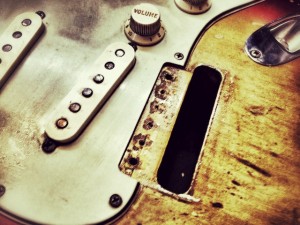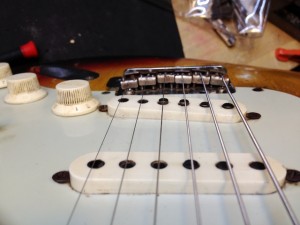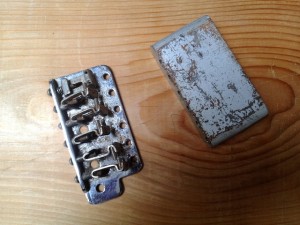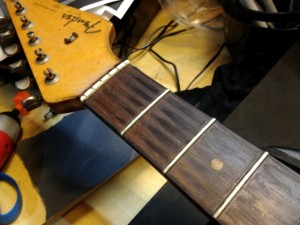
This photo was digitally altered to make the guitar look even dirtier than it was — but not by much.
Sometimes only the threat of public exposure can inspire a proper clean-up job. Case in point: I hadn’t groomed my battered ’63 Strat in years, and when I pupped it from the wall for my recent post on the instrument, the fact that I was about to show it to the world you guys made me finally admit how gross it had become.
Now, it’s not like I wanted it to sparkle or anything — seems to me that an old guitar should look old, and removing 100% of the grime would be a little too much like those octogenarians with preternaturally white teeth. I mainly just wanted to remove the sticky crud that had accu
mulated at every spot where the guitar comes in contact with skin, especially on the fretboard and around the cutaways. I also used the opportunity to reinstall some of the guitar’s original hardware, which I’d replaced with “improved” parts sometime during the last ice age ’80s.
First, credit where it’s due: Most of what I did was based on the wisdom of my former Guitar Player mag colleague Dan Erliwine, who’s always right about everything. If you have any interest in maintaining or modding your own instruments, you must acquire his The Guitar Player Repair Guide and How to Make Your Electric Guitar Play Great, like, yesterday. I keep both on my workbench iPad.
Since I wanted to reinstate the original bridge and bridge block, I started by removing the strings, bridge, and trem assembly. Amazingly, I located the original parts, which were pitted and rusty. I soaked them overnight in a jar of naptha, a petroleum-based solvent that’s pretty much the same thing as lighter fluid. (It’s fairly nasty stuff, so the usual skin/eye protection and ventilation rules apply.) Following Dan E.’s advice, I added a few drops of 3-in-1-style lubricant. The toxic bath didn’t make the parts look new, but it worked loose most of the crud and some of the rust. (If I were less lazy, I might also have soaked the knobs and selector switch in a cup of warm water with some dishwashing detergent added.)
Next, I started on the body, seeing how much of the grime would come off with a soft cloth dampened with warm water. The answer: almost none. The experts urge caution in applying solvents to old finishes, but some escalation was necessary. So I dipped poured a bit of naphta into a soft rag, and then flapped the rag around till most of the fluid had evaporated.
This was much more effective. And anyway, the original sunburst finish was so badly worn that I hardly minded when all the old orange and red paint peeled away, exposing the bare wood beneath. JUST KIDDING! This light naptha rub-down caused no new damage, and after a few minutes of work, the guitar no longer looked like it had stashed behind a deep-fryer for a decade.
The fretboard was a tougher chore. There was hard-packed grime parallel to the strings and against the frets. I used to rely on the time-honored technique of 0000 steel wool dipped in warm water with a touch of dishwashing liquid, followed by a light coat of linseed oil. But I’m a recent convent to Gorgomyte Fret Conditioning Cloth, a pre-lubricated cloth that cleans and conditions remarkably well. It’s ten bucks a package, but a two-inch swatch generally does the job, so you can usually get eight or so cleanings from a single purchase.
But this wasn’t your average clean-up job. I wound up turning to another Erliwine-approved technique: very carefully scraping the frets, squeegee-style, with the edge of a metal rule. The loosened almost all of the grime, and a second Gorgomyte application finished the job. The fingerboard felt great, and the frets were now clean and shiny. I also used the cloth to remove a bit more crud from the back of the neck and headstock.
(Note that these are good techniques for a rosewood fingerboard like mine, but if you’re working on a maple fingerboard with an old-school finish, you should avoid any abrasives, and use only water and/or naptha — even mild scraping can leave permanent marks, as I learned for myself while building this mutant Strat. I should have reviewed Dan’s books first….)
Setup was simple, since for now I just wanted to batten down the bridge and set the intonation and action. These days, I make all such adjustments chiefly by ear and feel. I restring, and then start with the intonation, using the harmonics method: a harmonic played at the 12th or 19th fret should be the exact same pitch as the fretted notes at the same location. The harmonics, by definition, and in tune — you just need to slide the saddles back and forth till the fretted notes match. (If the fretted note is higher than the harmonic, the saddle is too close to the nut, and you need to tighten the screw to add a tiny bit of string length, resulting in a lower fretted pitch.) You can use a tuner if you don’t trust your ear.

Sighting down the neck toward the bridge can help you fine-tune relative string height — but your best tool is probably pure feel.
I also took Dan’s advice and used a fret radius gauge to set the relative string height. And as usual, this method didn’t work for me, though your mileage may vary. Even when I don’t play with a detuned sixth string (and I usually do), I tend to favor higher action on the low strings. (My fifth and sixth strings often wind up at parellel height to the fourth string, as opposed to sloping down slightly to mirror the radius of the neck.) So as usual, I wound up alternating between playing and sighting down the neck, making back-and-forth adjustments until everything felt good to me.
And that did it — now I had an attractively dirty guitar rather than a disgustingly dirty one! You can see the results here.
And how about you guys? Have any favorite cleaning and conditioning tips? Especially for those super-gross clean-up jobs? Please share!










Total trivia, and nothing to do with cleaning guitars, but I just wanted to mention the little-remembered fact that Dan Erlewine was also a former bandmate of Iggy Pop, in Iggy’s pre-Stooges band, the Prime Movers.
yes he was – as was his brother I believe. Are you an Ann Arbor guy?
True! Full story here.
There’s something about the pH in my sweaty hands that eats strings. I have to wipe down the guitar daily, and still have to go through the string-off thorough cleaning on a regular basis. I have referenced Dan’s books for the last 20 years or so (since he published the first edition of his Repair Guide), and can’t recommend them enough.
You will never rival one of my former colleagues at Guitar Player, who could pick up a fresh guitar and strum a C chord, and every string would have a thick infestation of filthy-rusty crud. The strings felt like they’d been breaded and fried.
Okay, I’m exaggerating. But not by a whole lot. Some people just have that “lucky” chemistry!
I’m not sayin’ who I’m talking about — but it’s not Tom or Jas! 🙂
I use Triflow Oil instead of 3 in 1 it’s just all around better stuff, I soak my entire bridge in it too especially on an old floyd.Pretty much standard stuff and techniques you are using.I have gone to removing the paint from necks and Tung Oil , I just like it so much more.Every guitar of mine has it’s own rag that sits on the head stock. I wash my hands before playing and wipe down the strings every time I touch one.Preventive maintenance will make your guitar play better and stay in good shape longer if you just spend a few moments and make the effort.
Thanks Joe, some good pointers there; Lord knows I need ’em…Dunlop 65 barely cut through the surface goop the last time I attempted to clean up my 335. I figure if it gets disgusting enough people will quit asking me if they can borrow it. Mind you, the best cure for that is having a .14 1st string on a guitar otherwise set up for .11’s- that makes people nervous!
A safer method IMO, then using a straight edge (or a razor! yes, I’ve seen that) is to:
1) Use a thick pick and slowly scrape along the grain to get the thick particulate grim
2) A cloth and Naptha (lighter fluid). Put a few drops on the cloth and wipe each fret with some moderate force (remember not to press any nails to the fingerboard). Naptha really gets the hard grim off easy
3) 0000 steel wool. Use this, again along the grain. It will get the smaller portions, around the frets and also polish the fret wires up.
Easy and cheap method, makes the fingerboard as good as new!
I have a stupid question: How did you get those books on your iPad? I couldn’t find them in the iBooks Store. Thanks!
Not a dumb question at all — it took me a while to figure it out too!
Like many Mac geeks, I was ready rely on the iTunes store for ebook purchases. But now, after a couple of years on iPad, I’m likelier to use Amazon’s Kindle store. (I no longer own a Kindle — I just use the free Kindle app on iOS.) When the iBooks apps debuted, it kicked ass on Kindle, but Kindle has caught up, and now the two offer very similar reader experiences. Meanwhile, the Kindle store includes many titles iBooks does not, and for some abstruse legalistic reason, it’s STILL impossible to “gift” an iBook, while it’s easy to purchase Kindle books for family and friends.
Gotcha! I haven’t used much time with e-books on my iPad since I’m blind, but I figured it might be nice to have some guitar reference stuff for when I’m fiddling with my axes. Thanks for your quick reply!
I’ve worked on a number of filthy guitars lately. The muck almost seems to build up in layers, there’s the top grime layer and you can get most of that off with a cloth damped with water and detergent. Then the nitro-celullose finishes in particular seem to develop a decomposed layer on the surface of the finish. That does seem to come of with naptha but I find you are never sure if you are just stripping the finish off completely! I use a fine abrasive polish designed for polishing perspex / acrylic and keep rubbing until a shine appears.
0000 steel wool can produce great results, but boy does it make a mess. Tends to get stuck to your pickups too, even when you mask them first. Apparently there are some 3M fine abrasive papers that work as well as steel wool but aren’t so messy.
Finally I spray on a bit of beeswax furniture polish (no silicone) spread it out and let it dry and then buff it off with a soft cloth. I have had some very good results with this, with some beaten up old guitars restored to almost new condition. The beeswax works great on fretboards too, lemon oil just sinks in to the wood and goes dull. Beeswax is also adsorbed but it leaves a nice surface sheen as well.
Old Fender saddles I inspect for string notches and if present I file and polish them out. I used to set the Fender style saddles with one screw set shorter than the other, so all the saddles appeared to follow the fretboard radius, but I found that this resulted in uneven pressure and the strings and saddles tended to walk around as the trem was used. Now I set all the saddles with their tops parallel to the bridge plate. What do you guys think?